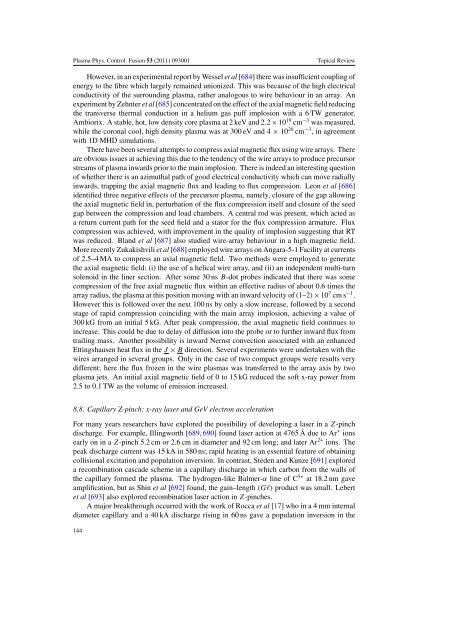Create successful ePaper yourself
Turn your PDF publications into a flip-book with our unique Google optimized e-Paper software.
Plasma Phys. Control. Fusion 53 (2011) 093001<br />
Topical Review<br />
However, in an experimental report by Wessel et al [684] <strong>the</strong>re was insufficient coupling <strong>of</strong><br />
energy to <strong>the</strong> fibre which largely remained unionized. This was because <strong>of</strong> <strong>the</strong> high electrical<br />
conductivity <strong>of</strong> <strong>the</strong> surrounding plasma, ra<strong>the</strong>r analogous to wire behaviour in an array. An<br />
experiment by Zehnter et al [685] concentrated on <strong>the</strong> effect <strong>of</strong> <strong>the</strong> axial magnetic field reducing<br />
<strong>the</strong> transverse <strong>the</strong>rmal conduction in a helium gas puff implosion with a 6 TW generator,<br />
Ambiorix. A stable, hot, low density core plasma at 2 keV and 2.2 ×10 19 cm −3 was measured,<br />
while <strong>the</strong> coronal cool, high density plasma was at 300 eV and 4 × 10 20 cm −3 , in agreement<br />
with 1D MHD simulations.<br />
There have been several attempts to compress axial magnetic flux using wire arrays. There<br />
are obvious issues at achieving this due to <strong>the</strong> tendency <strong>of</strong> <strong>the</strong> wire arrays to produce precursor<br />
streams <strong>of</strong> plasma inwards prior to <strong>the</strong> main implosion. There is indeed an interesting question<br />
<strong>of</strong> whe<strong>the</strong>r <strong>the</strong>re is an azimuthal path <strong>of</strong> good electrical conductivity which can move radially<br />
inwards, trapping <strong>the</strong> axial magnetic flux and leading to flux compression. Leon et al [686]<br />
identified three negative effects <strong>of</strong> <strong>the</strong> precursor plasma, namely, closure <strong>of</strong> <strong>the</strong> gap allowing<br />
<strong>the</strong> axial magnetic field in, perturbation <strong>of</strong> <strong>the</strong> flux compression itself and closure <strong>of</strong> <strong>the</strong> seed<br />
gap between <strong>the</strong> compression and load chambers. A central rod was present, which acted as<br />
a return current path for <strong>the</strong> seed field and a stator for <strong>the</strong> flux compression armature. Flux<br />
compression was achieved, with improvement in <strong>the</strong> quality <strong>of</strong> implosion suggesting that RT<br />
was reduced. Bland et al [687] also studied wire-array behaviour in a high magnetic field.<br />
More recently Zukakishvili et al [688] employed wire arrays on Angara-5-1 Facility at currents<br />
<strong>of</strong> 2.5–4 MA to compress an axial magnetic field. Two methods were employed to generate<br />
<strong>the</strong> axial magnetic field: (i) <strong>the</strong> use <strong>of</strong> a helical wire array, and (ii) an independent multi-turn<br />
solenoid in <strong>the</strong> liner section. After some 30 ns B-dot probes indicated that <strong>the</strong>re was some<br />
compression <strong>of</strong> <strong>the</strong> free axial magnetic flux within an effective radius <strong>of</strong> about 0.6 times <strong>the</strong><br />
array radius, <strong>the</strong> plasma at this position moving with an inward velocity <strong>of</strong> (1–2) × 10 7 cm s −1 .<br />
However this is followed over <strong>the</strong> next 100 ns by only a slow increase, followed by a second<br />
stage <strong>of</strong> rapid compression coinciding with <strong>the</strong> main array implosion, achieving a value <strong>of</strong><br />
300 kG from an initial 5 kG. After peak compression, <strong>the</strong> axial magnetic field continues to<br />
increase. This could be due to delay <strong>of</strong> diffusion into <strong>the</strong> probe or to fur<strong>the</strong>r inward flux from<br />
trailing mass. Ano<strong>the</strong>r possibility is inward Nernst convection associated with an enhanced<br />
Ettingshausen heat flux in <strong>the</strong> J × B direction. Several experiments were undertaken with <strong>the</strong><br />
wires arranged in several groups. Only in <strong>the</strong> case <strong>of</strong> two compact groups were results very<br />
different; here <strong>the</strong> flux frozen in <strong>the</strong> wire plasmas was transferred to <strong>the</strong> array axis by two<br />
plasma jets. An initial axial magnetic field <strong>of</strong> 0 to 15 kG reduced <strong>the</strong> s<strong>of</strong>t x-ray power from<br />
2.5 to 0.1 TW as <strong>the</strong> volume <strong>of</strong> emission increased.<br />
8.8. Capillary Z-<strong>pinch</strong>: x-ray laser and GeV electron acceleration<br />
For many years researchers have explored <strong>the</strong> possibility <strong>of</strong> developing a laser in a Z-<strong>pinch</strong><br />
discharge. For example, Illingworth [689, 690] found laser action at 4765 Å due to Ar + ions<br />
early on in a Z-<strong>pinch</strong> 5.2 cm or 2.6 cm in diameter and 92 cm long; and later Ar 2+ ions. The<br />
peak discharge current was 15 kA in 580 ns; rapid heating is an essential feature <strong>of</strong> obtaining<br />
collisional excitation and population inversion. In contrast, Steden and Kunze [691] explored<br />
a recombination cascade scheme in a capillary discharge in which carbon from <strong>the</strong> walls <strong>of</strong><br />
<strong>the</strong> capillary formed <strong>the</strong> plasma. The hydrogen-like Balmer-α line <strong>of</strong> C 5+ at 18.2 nm gave<br />
amplification, but as Shin et al [692] found, <strong>the</strong> gain–length (Gl) product was small. Lebert<br />
et al [693] also explored recombination laser action in Z-<strong>pinch</strong>es.<br />
A major breakthrough occurred with <strong>the</strong> work <strong>of</strong> Rocca et al [17] who in a 4 mm internal<br />
diameter capillary and a 40 kA discharge rising in 60 ns gave a population inversion in <strong>the</strong><br />
144














